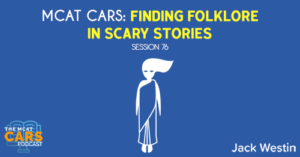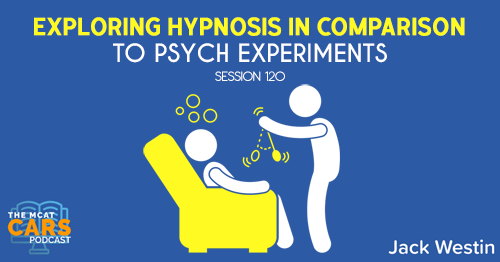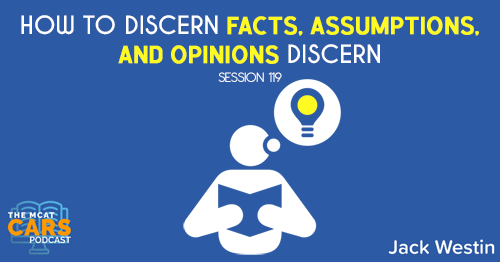Apple Podcasts | Google Podcasts

Session 76
Are scary stories little more than folktales and urban legends told in the dark? How has folklore contributed to the rise in their popularity? Let’s dive in!
As always, we’re joined by Jack Westin, the premier online CARS tutor. Go check out the free trial sessions of his course. Also, check out Meded Media for more podcasts and premed resources.
Link to article:
https://daily.jstor.org/the-folklorist-behind-scary-stories-to-tell-in-the-dark/
The new movie Scary Stories to Tell in the Dark, from André Øvredal and Guillermo del Toro, has kids of the ’80s and ’90s reminiscing about the terrifying source material. Written by Alvin Schwartz—and distinguished by Stephen Gammell’s gruesome illustrations—the original series of Scary Stories books (published in 1981, 1984, and 1991) were fervently swapped at school libraries and sleepovers alike. To Schwartz’s readers, hitchhikers, scarecrows, skin bumps, and green ribbons never looked the same.
Upon reexamination in the light, these stories are as simple and plainly told as folktales and urban legends. Which is exactly what they were. Schwartz, the man behind your childhood nightmares, was in fact a scholarly folklorist, author of more than fifty books, and the father to four children, who helped him to develop his work. As the children’s literature scholar Sylvia M. Vardell writes: “Who has done for folklore for children in the United States what the Grimm brothers did in Germany…? Alvin Schwartz, that’s who!”
Schwartz began collecting folklore in the early 1970s, conducting extensive research and interviews to uncover engaging tales. In a Q&A for Language Arts, Schwartz tells Vardell that his process involves learning everything he can about a genre, discussing each topic with scholars and folklorists, and doing extensive research at Princeton University’s Firestone Library. “What’s interesting is that eventually patterns emerge,” he says.
He also reveals that he thinks of all his stories as oral folktales. His process, therefore, includes reading his writing aloud to himself in the bathroom (“because the acoustics are so good”) three or four times to make sure it all sounds right. (Let’s hope he didn’t experience what the movie’s trailer suggests: “If we repeat stories often enough, they become real.”)
So why are these stories so uniquely terrifying? And why have kids devoured them throughout the decades? Schwartz claims to just follow his gut when it comes to figuring out what kids will like. He also acknowledges that stories once written for adults, like the chilling tales in Scary Stories, now work for children, since kids have “gotten so sophisticated.” This comment, however, was made in 1987, and it’s worth noting that after years of PTAs and concerned parents banning the Scary Stories series, they were re-released with much gentler illustrations. It’s hard to say whether this is reflective of kids’ or adults’ levels of “sophistication.”
[03:09] Paragraph 1, Sentence 1
The new movie Scary Stories to Tell in the Dark, from André Øvredal and Guillermo del Toro, has kids of the ’80s and ’90s reminiscing about the terrifying source material.
Jack says:
It’s a book but it’s probably adapted from some sort of novel as source material and terrifying source music so we know it’s a scary movie. And it’s from the 80s or 90s.
[04:09] Paragraph 1, Sentence 2
Written by Alvin Schwartz—and distinguished by Stephen Gammell’s gruesome illustrations—the original series of Scary Stories books (published in 1981, 1984, and 1991) were fervently swapped at school libraries and sleepovers alike.
Jack says:
We’re given this source material. Three different books here and apparently they were very popular fervently swapped at school libraries and sleepovers.
[05:04] Paragraph 1, Sentence 3
To Schwartz’s readers, hitchhikers, scarecrows, skin bumps, and green ribbons never looked the same.
Jack says:
The people who read these books didn’t see hitchhiker, scarecrows, and skin bumps the same. Apparently, those were topics in the book. You have to assume that these are topics in the book and they’re not seeing the same because people are scared of them now.
The book was probably talking about hitchhikers in a scary way and scarecrows in a scary way. That’s what this sentence is trying to say. So if you read the sentence, you had no idea what’s going on, refer back to what you’re reading. Visualize it. You’re thinking about scary stories. So you’re not going to see something the same way.
[05:57] Paragraph 2, Sentence 1
Upon reexamination in the light, these stories are as simple and plainly told as folktales and urban legends.
Jack says:
The author basically saying they’re coming from folktales and urban legends.
[06:25] Paragraph 2, Sentence 2
Which is exactly what they were.
Jack says:
They were folktales and urban legends.
[06:32] Paragraph 2, Sentence 3
Schwartz, the man behind your childhood nightmares, was in fact a scholarly folklorist, author of more than fifty books, and the father to four children, who helped him to develop his work.
Jack says:
The first paragraph talked about how popular it is, how captivating the movie and these books are. The second paragraph is talking about that you know these books and movies are basically coming from folktales and urban legends.
What is a really strong assumption you can make that the author never said, not yet at least, is not that folklore is scary. But that you can use folklore to create scary stories. Because not all folklore is are necessarily scary, but you can adapt or use parts of a folklore to make something popular.
[07:38] Paragraph 2, Sentence 4
As the children’s literature scholar Sylvia M. Vardell writes: “Who has done for folklore for children in the United States what the Grimm brothers did in Germany…? Alvin Schwartz, that’s who!”
Jack says:
What’s more important is that you associate folklore to Swartz.
[08:22] Paragraph 3, Sentence 1
Schwartz began collecting folklore in the early 1970s, conducting extensive research and interviews to uncover engaging tales.
Jack says:
It’s about Schwartz and when he started his journey.
[08:36] Paragraph 3, Sentence 2
In a Q&A for Language Arts, Schwartz tells Vardell that his process involves learning everything he can about a genre, discussing each topic with scholars and folklorists, and doing extensive research at Princeton University’s Firestone Library.
Jack says:
We have this interview with this literature scholar bardell. And basically just dive in into the research that Schwartz does.
[09:03] Paragraph 3, Sentence 3
“What’s interesting is that eventually patterns emerge,” he says.
Jack says:
Just more about the research or study.
[09:20] Paragraph 4, Sentence 1
In working with “scary story” material, one finds five or six or seven typologies.
Jack says:
It’s just more of the process.
[09:30] Paragraph 4, Sentence 2
I was not aware of this with Scary Stories until I began searching the material and putting it together.
Jack says:
More process.
[09:40] Paragraph 4, Sentence 3
Sometimes I will go so far as to study the structure of an item to see how it works, because this is important in making selections.
Jack says:
This paragraph really just tells us kind of scorches beginnings of this folklore and really just how much research he does for his work. And that there are six or seven types of kind of folklore that you could use.
[10:15] Paragraph 5, Sentence 1
He also reveals that he thinks of all his stories as oral folktales.
Jack says:
It’s a little bit more of the process here and that he thinks of them for storytelling, really not written stories, but for telling out loud.
[10:36] Paragraph 5, Sentence 2
His process, therefore, includes reading his writing aloud to himself in the bathroom (“because the acoustics are so good”) three or four times to make sure it all sounds right.
Jack says:
More process here.
[11:13] Paragraph 5, Sentence 3
(Let’s hope he didn’t experience what the movie’s trailer suggests: “If we repeat stories often enough, they become real.”)
Jack says:
You have to realize this is a conversation. So now every sentence is going to be equally weighted. And that’s very different than a textbook. Because in a textbook, I can imagine a pre-medical student or anyone really analyzing every sentence memorizing it really trying hard. That’s not going to happen here. This is more of a flow. It’s an ebb and flow.
“Be willing to embrace that certain sentences are very important. Some of them are not so important. But just knowing the difference is going to help you a lot.”Click To Tweet[12:05] Paragraph 6, Sentence 1
So why are these stories so uniquely terrifying?
Jack says:
The author is asking a question. We were talking about folklore this whole time. Now we’re going back to scary stuff. It’s a good transition for the author.
[12:38] Paragraph 6, Sentence 2
And why have kids devoured them throughout the decades?
Jack says:
So why are they terrifying? Why are they so popular? That’s the author’s asking these questions. I want to know
[12:50] Paragraph 6, Sentence 3
Schwartz claims to just follow his gut when it comes to figuring out what kids will like.
Jack says:
He’s got a good microbiome of what it’s like.
[13:02] Paragraph 6, Sentence 4
He also acknowledges that stories once written for adults, like the chilling tales in Scary Stories, now work for children, since kids have “gotten so sophisticated.”
Jack says:
Apparently scary stories. It was written for adults, but kids love them now.
[13:31] Paragraph 6, Sentence 5
This comment, however, was made in 1987, and it’s worth noting that after years of PTAs and concerned parents banning the Scary Stories series, they were re-released with much gentler illustrations.
Jack says:
We get a little bit of a history here how parents and teachers potentially alike didn’t like them, but maybe just because of the illustrations and they rereleased them. Now, it’s showing some skepticism. Parents didn’t like them, and if it’s true that the children are more sophisticated, why would the parents not accept it? It’s casting some sort of doubt.
[14:40] Paragraph 6, Sentence 6
It’s hard to say whether this is reflective of kids’ or adults’ levels of “sophistication.”
Jack says:
It’s hard to say whether this is reflective of kids or adults levels of sophistication.
[14:53] The Main Idea
We have this story and this passage here about scary stories. And the author and the process that the author goes through and how popular the books are rejected at some point by parents.
Scary stories are popular. But they were probably popular because they resemble folklore. Most of this is tied to folklore.
Links:
Link to article:
https://daily.jstor.org/the-folklorist-behind-scary-stories-to-tell-in-the-dark/
SEARCH SITE
SEARCH SITE
LISTEN FOR FREE











